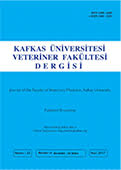
This journal is licensed under a Creative Commons Attribution-NonCommercial 4.0 International License
Kafkas Üniversitesi Veteriner Fakültesi Dergisi
2017 , Vol 23 , Issue 6
Determination of Virulence Factors of Staphylococci Isolated from Bovine Mastitis
1Adnan Menderes University, Faculty of Veterinary Medicine, Department of Microbiology, TR-09010 Işıklı/Aydın - TURKEY2Ondokuz Mayis University, Faculty of Veterinary Medicine, Department of Microbiology, TR-55220 Atakum/Samsun -TURKEY DOI : 10.9775/kvfd.2017.18015 Staphylococcal mastitis is one of the major economic problems of cattle. The aim of this study was to identify Staphylococcus species that cause mastitis, to examine the virulence factors of these species and to determine the relation between these factors with the pathogenic and nonpathogenic species. In the study, 37 S. aureus, 13 S. hyicus, 9 S. simulans, 8 S. chromogenes, 5 S. lentus, 5 S. epidermidis, 2 S. haemolyticus, 2 S. hominis, 1 S. auricularis, 1 S. warneri, 1 S. sciuri were isolated and identified. The 41.6% of strains were determined as coagulase positive. In the coagulase positive strains, the rate of protein A, DNase, TNase, capsul, hemolyse, staphylokinase, slime (in agar), biofilm (microdilution) and hemagglutination characteristics were found 71.4%, 48.6%, 11.4%, 40%, 97.1%, 40%, 28.6%, 37.1% and 17.1%, respectively. In the coagulase negative strains, the rate of these characteristics were found 10.2%, 12.2%, 2%, 8.2%, 82%, 32.7%, 12.2%, 12.2% and 10.2%, respectively. The methicillin resistance rates in the coagulase positive and negative strains were determined as 2.9 and 16.3%. In conclusion, it was of the opinion that animals are potential carriers of staphylococcus strains that are pathogen for human. Keywords : Bovine, Mastitis, Staphylococci, Virulence










